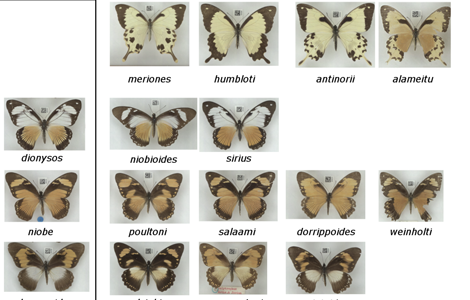Butterfly collection pinpoints brilliance of mimicry

New research on the Museum's Lepidoptera collection has shed light on how some butterflies pretend to be lethal.
For decades, biologists have been intrigued by the staggering diversity of wing patterns within certain butterfly species, in particular the mocker swallowtail, Papilio dardanus.
The array of different forms exhibited by this African butterfly, now estimated at between 11 and 18, meant that until 1869, they were often described as belonging to separate species.
Fooling the enemy
P. dardanus is a textbook example of a successful Batesian mimic - an edible butterfly species in which the females take on the colours and wing patterns of toxic species to ward off predators.
Successful mimics such as P. dardanus cannot afford to become more abundant than the species they're copying otherwise predators, such as baby birds, learn that they're safe to eat.
This means its appearance continually evolves to maintain the wariness of predators.
In a new study published this week in Plos One, Cambridge University PhD researcher Martin Thompson databased and geocoded the 3,395 wild specimens preserved in the Museum's pinned collection to help explain the existence of 'imperfect' intermediates - non-mimetic female butterflies, believed to have resulted from a breakdown of the mimetic pattern.
Broken brilliance
'In other words, we wanted to see if something goes wrong in certain geographical locations that breaks down the dominance hierarchy and makes some of the butterflies no longer mimics,' Thompson said.
The collection shows is a clear divergence between butterfly populations in East and West Africa, across the rift valley, suggesting the butterflies adapt to separate environments with cross-breeding in the middle producing unpredictable outcomes.
It could be, however, that being an inaccurate mimic in these areas does not put the butterflies at risk because of a lack of predators, or it could simply mean there are a fewer distasteful species to mimic.
Thompson said the Museum's Lepidoptera collection allowed the team to plot the hotspots for the different P. dardanus wing patterns, for example the area of East Africa surrounding Lake Victoria in Uganda and Kenya, which hopefully will lead to more work to understand the genetics behind successful mimicry.
Sensational Butterflies on display
The team behind the Plos One paper is about to publish further research on the DNA of P. dardanus supplied by specimens that successfully emerged in the Museum's live butterfly house last year.
Although a tropical butterfly, there are currently live P. dardanus in the Museum's Sensational Butterflies exhibition, with more hopefully about to emerge.
Other swallowtails belonging to the Papilio group can also be seen in the butterfly house, which is open to the public until 14 September 2014.
There is also a display of P. dardanus specimens in Dinosaur Way in the Blue Zone.
More information: Thompson MJ, Timmermans MJTN (2014) "Characterising the Phenotypic Diversity of Papilio dardanus Wing Patterns Using an Extensive Museum Collection." PLoS ONE 9(5): e96815. DOI: 10.1371/journal.pone.0096815
Journal information: PLoS ONE
Provided by Natural History Museum





















